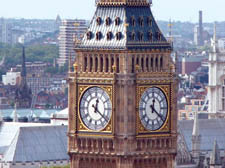|
|
 |
| |
 Big Ben Big Ben |
Parliament’s grand designer
WHILE many have heard of him, few people know exactly who Pugin was and what he did. Rosemary Hill’s book God’s Architect fleshes out an extraordinary life and fills a real gap in our knowledge of a man who, if not England’s greatest architect, has claims to being its greatest designer. Augustus Welby Northmore Pugin, born in Bloomsbury in 1812, was the son of the artist and illustrator Augustus Charles Pugin, a refugee from the French Revolution of Swiss descent.
Unbusinesslike, hugely energetic, carelessly dressed, controversial on paper but warm-hearted in person, Pugin had designed furniture for George IV’s Windsor Castle by the age of 15, had become a successful theatrical scene painter by 17 and had converted by Catholicism by 18. By 21 he had also been shipwrecked, imprisoned for debt and widowered. If anything, the pace then quickened.
Pugin was astonishingly prolific in designing churches, houses, furniture, jewellery, glass, tiles, plate, wallpaper and even dresses. The complexity of his output was compounded by the fact that on all these his ideas and methods seldom stood still. The architect of the supremely ornate church of St Giles, Cheadle, could also produce a plain family home 50 years ahead of its date, and functional furniture prefiguring William Morris and the Arts and Crafts movement. His greatest achievement was the interior of Charles Barry’s new Houses of Parliament. All the decorative designs were Pugin’s, as was the outline for the clock-tower of Ben Ben.
Pugin’s personal life was marked by characteristic intensity. Having married one penniless dancer, who died in childbirth, he promptly married another one. He designed and built his own brilliantly idiosyncratic house, The Grange at Ramsgate.
For the last 10 years of his life his health became increasingly bad, with violent emotional swings, but there was no slackening in pace. It all culminated in a complete mental breakdown and incarceration in Bedlam.
There can be little doubt, despite leaving eight children by three wives, that his death, at the age of 40 in 1852, was the result of syphilis, probably contracted in his teens when working in the louche world of Covent Garden. His madness and early death and his failure to promote himself overshadowed his reputation. This fine biography now brings a very remarkable man back to life.
Martin Sheppard
|
 |
|
 |
 |
|
 |
|



